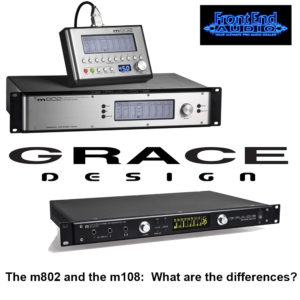What are the differences between the m802 and the m108, and why is the m108 half the price?
By Front End Audio on Aug 25th 2016

What are the differences between the m802 and the m108, and why is the m108 half the price?
Earlier in 2016, Grace Design debuted their new Grace Design m108 Preamp. Not only is it half the size of any 8-channel offering that Grace has bowed to date, it also sports a host of features that the m801 and m802 have never had. In fact, the m108 is replacing the m802, which has been Grace Design's remote control preamplifier.
Let's dive in...
At the core, both mic preamplifiers are quite similar. They both utilize Grace Design's signature transimpedance (or current feedback) amplifier topology, they have no electrolytic capacitors in their signal paths, and each preamp channel has its own power supply voltage regulators. These are the key ingredients in how Grace designs their mic preamplifiers, which lend very similar sonic performance to both units. However, there are many differences in design execution and features:
- The m802 has external, dual redundant power supplies. The power supply unit used in the m108 is the same as the m802 and m905, but the m802 uses two of them for NASA level reliability (more expensive). Redundant or not, this design is currently 100% reliable, without a single failure in the field since the 6 years they have been deployed.
- The m802 has two adjustable ADC sensitivity settings which are accessible via setup menus. This requires a fair amount of additional circuitry and components (more expensive). The m108 ADC sensitivity is fixed at +24dBu or +18dBu (at the analog output) for 0dBFS and is changed via internal jumpers (less expensive).
- The m802 ribbon mode uses a relay to bypass the input phantom power blocking capacitors (more expensive). In the m108, Grace Design uses very high quality metalized film capacitors for this which are exceedingly transparent sounding (less expensive).
- The m802 has two sets of balanced analog outputs (more expensive) while the m108 has one set (less expensive).
- The m802 has separate circuit boards for the preamps, a back plane pcb for interconnect, a controller pcb, and 4 pcbs in the ADC assembly,15 circuit boards in all (very expensive). The m108 has its preamplifiers, ADC, and controller all on one pcb and the digital I/O on another (less expensive). This really makes up the bulk of the cost savings between the two units. As well there are fewer interconnect cables which means less chance of a contact failure.
- The m108 has the latest generation clock technology. The clock jitter in the m108 clock is less than 40ps and the PLL has a low frequency corner of around 500mHz (the m802 PLL corner frequency is 10Hz). This gives the m108 an extremely effective barrier to external clock jitter. We are unable to measure any effects of external jitter even at exceedingly high levels which would not be found in a modern well designed digital audio system.
- The measured performance of the m108 slightly exceeds that of the m802 in most areas. These include ADC dynamic range, THD+N, external clock jitter rejection.
The rest of the differences are in features, size, weight, and power consumption. The m108 represents the single biggest R&D effort in our company's history. Grace Design really focused on increasing performance and maintaining bomb-proof reliability while reducing the cost of the system. The folks at Grace Design are really proud of this unit and are amazed with its stunning clarity and musicality.
We are too!






 Sign Up for exclusive sales and offers!
Sign Up for exclusive sales and offers!